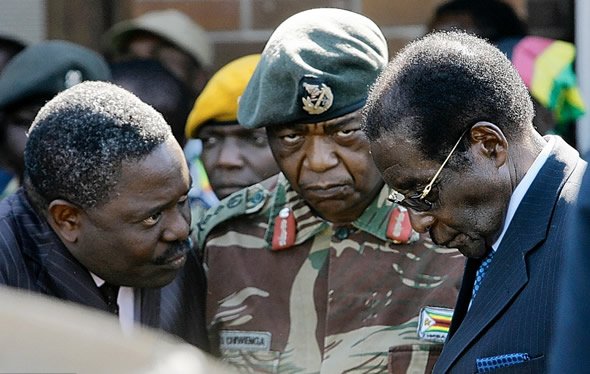


A BATTLE for top positions has ensued in ZANU-PF as party heavyweights prepare for a do-or-die congress in December amid indications that Simon Khaya-Moyo, the party’s national chairman, and Didymus Mutasa, the secretary general, will move a notch up the ladder from their respective positions if they play their cards right.
Whereas canvassing is known to start a month or two before the elective congress, ZANU-PF bigwigs broke the long-standing tradition by hitting the campaign trail, lobbying for support across the country’s 10 political provinces, albeit clandestinely. There is so much significance being placed on the coming congress, which explains the unprecedented interest it has generated.
The congress is likely to be the last before President Robert Mugabe retires from active politics. By the time ZANU-PF holds its next congress, after the coming one, in 2019, the incumbent would have turned 95 as he was born in February 1924. The battle for positions should therefore be seen in the context of President Mugabe’s succession because whoever would be closest to the top office in terms of rank stands a good chance of making it to the top in the event that the incumbent exits the political stage.
In terms of the new Constitution, the first Vice-President assumes office as President if the incumbent dies, resigns or is removed from office until the expiry of the former’s term of office. But there are also economic interests at play. Those in ZANU-PF who have accumulated wealth would want to amass political muscle as well to safeguard their economic interests.
Focus for ZANU-PF bigwigs eyeing top positions has been to ensure that the youth and women’s wings of the party are aligned to their interests with regards their leadership when they meet to elect new office bearers around August. The two organs, along with the war veterans, play an influential role in mobilising support for their preferred candidates.
Jockeying for positions in the women and youth leagues has since started, taking the character of the factional fights in ZANU-PF – a dress rehearsal of much bigger fight to follow ahead of the main congress. ZANU-PF holds its congress after every five years. The infighting in ZANU-PF is seen divided into two factions namely one led by Vice President Joice Mujuru and the other aligned to Justice Minister Emmerson Mnangagwa, who is the party’s secretary for legal affairs. Mujuru and Mnangagwa have, however, denied leading factions.
But so intense has been the rivalry between the two camps that ZANU-PF had to dissolve District Coordinating Committees in June 2012 after internecine factional fights broke out. The infighting reared its ugly head again late last year resulting in chaos, vote rigging and vote buying tainting ZANU-PF’s provincial elections. With congress six months away, influential figures in ZANU-PF are leaving no stone unturned in pursuit of power.
President Mugabe, who has been at the help of ZANU-PF since 1975, will again face no opposition at the coming congress. His leadership of the ruling party effectively places him in the running to stand as ZANU-PF’s presidential candidate in the next 2018 elections. It is, however, not yet clear whether he will seek re-election at the general polls to stretch his rule to the eighth consecutive term in office. Previously, he has said his decision to stand would be guided by the people’s wishes.
His rural homeland of Zvimba last month agreed to support the veteran ruler to be nominated again for top job in ZANU-PF. As has happened before, all the other structures of the party will soon be falling over each other to endorse President Mugabe and clear the way for him for another term.
Mujuru is also assured of retaining her position uncontested after loyalists swept to victory in provincial elections held last year to ring-fence her first vice presidency from any potential threat. To further solidify her position, allies are engaged in horse trading whereby they are offering to back potential spoilers for any other position other than the first vice presidency.
Speculation has been rife that Oppah Muchinguri, the ZANU-PF Women’s League leader, may also have her eye on the vice presidency. But with the Mujuru camp clearly in an unassailable position, Muchinguri might be forced to cut a deal that might land her the secretary for administration’s post. Muchinguri told a women’s conference in Gweru that women must have ambitions for high office and saying they have already proven their clout by being involved in the war of liberation.
“We also want the presidency as women because during the war we fought side by side with men. Nothing can stop us from landing the top job because we have the revolutionary qualities,” she was quoted saying.
Widely expected to land the vacant post of second Vice President, which became available following the death of John Nkomo in January last year is Khaya Moyo, whose elevation is likely to set off more jostling for the seat he would have vacated. While the contest for the national chairman’s post, assuming that Khaya-Moyo moves up, is expected to be fierce, Mutasa is tipped for the position. There is already a convergence of interests emerging between Mujuru, Khaya-Moyo and Mutasa, which convergence has the effect of shutting out competition for the top four positions.
As such, whoever is likely to gain the fifth position – that of secretary for administration – in the event that Mutasa becomes the national chairman, would need the backing of the three most senior members of the party, after President Mugabe. For the first time since the Unity Accord was inked in 1987, the national chairman’s post is likely to land outside the circle of former ZAPU cadres. While the second vice presidency is earmarked for former ZAPU cadres, in terms of the Unity Accord signed between President Mugabe and the late Joshua Nkomo to end the disturbances that rocked the Midlands and Matabeleland provinces in the 1980s, the national chairmanship had always gone to ZAPU cadres.
But there has been pressure within ZANU-PF to do away with the gentlemen’s agreement, which previously benefited John Nkomo and before him Joseph Msika (also late) in favour of a hierarchical approach that would favour Mutasa. Provincial nominations are expected to start soon after guidelines have been put in place. The party’s highest decision-making body outside of congress, the Politburo, met to discuss a number of issues, among them the guidelines for the nomination process.
Observers suggested that the cobbling of guidelines six months away from the congress was indicative of the party’s intention to control fissures and prevent bloodletting that has often characterised the scramble for positions in the party. “It is also an admission that jostling for positions is alive and already in full swing,” a senior party insider explained this week ahead of yesterday’s Politburo meeting. Political commentator, Khanyile Mlotshwa, said the ruling party was likely to stick to the traditional hierarchy system to curtail upsets against the current leadership by ambitious members.
“It [ZANU-PF] has always been a disciplined party that does things according to a certain culture and tradition. There may be changes or people may wish for changes here and there in the party, but I am sure they will act in a restrained way because of protocols and seniority. The fireworks will not be so much of a public spectacle, but there will be movement within the party,” said Mlotshwa. Last year, the race for provincial leadership in the party’s 10 provinces betrayed infighting among party bigwigs and laid bare the factionalism that has rocked the party.